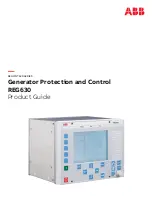
Notes
•
A phase-to-phase measurement is to be preferred for a single-phase
voltage measurement. If a single-phase input has to be chosen on both
sides, the same phase should be used wherever possible.
•
If a three-phase Y-connection is selected, phase-to-phase voltages are
formed internally. This reduces the harmonic content and enables the
function to continue to be used in ungrounded systems, which are
required to remain in service with a single ground fault.
•
According to the setting for
uBusInp-Ph and uLineInp-Ph, either one phase
or all three phases are monitored. Whether or not the conditions for
synchronism (dU, dPh and df) are fulfilled is determined on the basis of a
single phase, whereby the following conditions apply:
•
Where three phases are monitored on busbar and line sides, the
phase-to-phase potential U
L1L2
is the one extracted for further
processing.
•
Should a three-phase measurement be defined on one side and a
single-phase on the other, then the single-phase voltage set for the
single-phase input is used on both sides.
Measuring period (supervisTime), reset time (t-Reset), operating time of
the function and dead time of any autoreclosure function
Measuring period (supervisTime):
This adjustable delay time, which is initiated at the end of the pick-up time, is the period
during which all the conditions for synchronism must be continuously fulfilled to permit
closure of the circuit-breaker. The timer is reset should one of the parameters move out of the
permissible range.
Providing they all remain within their preset ranges, the enable signal (PermitToClose) is
issued at the end of the measuring period.
Especially, in autoreclosure applications, it is of advantage to set the measuring period
(
supervisTime) in relation to the settings for Phase diff. and maxFreqDif. It also provides
facility for allowing for the operating time of the circuit-breaker.
2
(' PhaseDiff ')
'supervisTime '
(
)
(' FreqDiff ')
Hz
360
s
tv
ts
s
where:
•
ts: circuit-breaker operating time
Typical range: 0 ... 100 ms
•
tv: time required by the function to pick up
(response by the function to transient phenomena in the input voltage and timer
tolerances):
typically 60... 80 ms for values of supervisTime <200 ms
typically 80... 100 ms for values of supervisTime ≥200 ms
The above setting for the measuring period ensures that for a constant frequency difference
df within the setting of maxFreqDif, the phase-shift dPh will still be inside the set permissible
angular range (- maxPhaseDif to + maxPhaseDif) at the end of the time
supervisTime.
Section 5
1MRK 505 406-UEN B
Bay protection functions
126
Bay protection functions REB500
Technical manual
© Copyright 2019 ABB. All rights reserved
















































